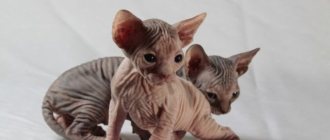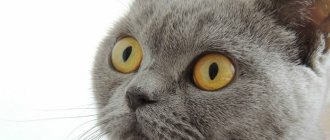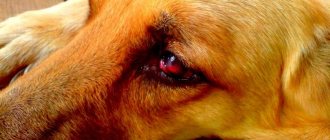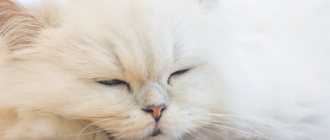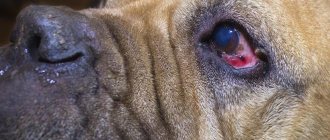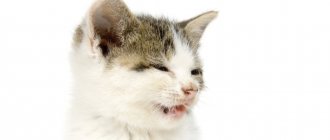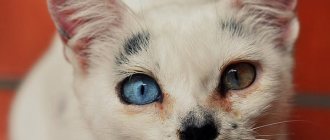Kitten sneezes and watery eyes
All cats sneeze from time to time and, I must admit, it looks pretty funny.
However, if a kitten is sneezing and its eyes are watery, this combination of symptoms should cause concern rather than a smile in its owner. The causes of sneezing in a kitten can be different. The most common are:
- Various infectious diseases;
- Allergic reaction to any irritant;
- Injury or foreign bodies in the nose
It can be extremely difficult to independently determine the exact causes of a pet’s illness and can only be done by a specialist.
There are situations in which it is impossible to get immediate qualified help. In this case, you can try to alleviate your pet’s condition by using our advice.
What if both at the same time?
Transparent discharge from both the eyes and nose, as well as sneezing, are symptoms of eye inflammation, which you can first try to treat at home: rinse with warm chamomile infusion. But only if no other deterioration is observed. However, even here, a doctor’s advice will not hurt, because a runny nose that is not completely cured can become chronic (and even... turn into pneumonia!).
If wheezing and swelling of the eyelids are added, then an allergy is quite possible (the same signs with an accidental one-time inhalation of powdery or sharp-smelling household chemicals). The condition will worsen if treatment is not started! Before visiting a doctor, try to first identify the allergen yourself (house dust, fungi and mold, plant pollen, household chemicals or strong odors, cigarette smoke) in order to relieve the sufferer from it.
If pus also flows along with the above, an increase in body temperature is already life-threatening symptoms of damage to the respiratory tract.
Manifestations of a viral infection, in addition to everything else, include poor appetite, lethargy, fever, sneezing, coughing, and dehydration. Serious, responsible and long-term treatment will be required.
What to do if your kitten starts sneezing frequently and his eyes are watery
First, pay attention to the behavior of the cat - if he periodically sneezes, his eyes are watery and often rubs his nose with his paw, this may indicate the presence of a foreign object in the nasal cavity. Carefully examine the kitten's nostrils and mouth - if you find any foreign objects or contaminants there, try to very carefully remove them using tweezers or small forceps. The main thing is not to harm the poor fellow by damaging blood vessels or mucous membranes with careless movement.
If you are not sure that you will be able to perform the manipulations safely for the animal, it is better to entrust them to a veterinarian.
If an external examination of the respiratory tract does not reveal the presence of foreign bodies in them, pay attention to whether mucus is secreted from the kitten’s nose. Its presence may indicate that the cat is sneezing and its eyes are watering due to an infectious disease or respiratory allergy. You can distinguish one from the other by determining the nature of this mucus. If the nasal discharge is clear, the cat most likely has an allergy; if the snot is gray or green, this may indicate that he is sneezing due to an infection.
What you can do yourself
If your pet's eyes water mainly after sleep, this is most likely a physiological phenomenon. It will be enough to carry out a hygienic eye cleaning procedure every day. You can wash your kitten's eyes with infusion of chamomile, calendula, St. John's wort, a solution of furatsilin or boric acid. There are special veterinary products for daily eye care - “Diamond Eyes”, “Bars”, “Beaphar Oftal”, “Clean Eye”. These products are hypoallergenic and do not cause burning.
The procedure for cleaning the eyes is carried out with a cotton sponge and a piece of gauze; it is not recommended to use cotton wool, as its fibers can remain under the eyelid and cause irritation.
Movements when cleaning the eyes should be very gentle, and directed from the outer corner of the eye to the inner. So that the kitten does not resist when such a manipulation is performed on him, and his eyes are wide open, he needs to be placed on his knees and, holding the skin on the back of his head, raise his head.
Infectious diseases
Various types of infections are one of the most common reasons why kittens’ eyes slowly water and they sneeze frequently. Like all babies, kittens have an underdeveloped immune system, which makes them vulnerable to viruses and bacteria.
In the autumn and spring months, cases of infectious rhinotracheitis are especially common in cats. This disease, in addition to the symptoms in question, can cause fever and a general deterioration in the animal’s condition. Drug treatment in this case is absolutely necessary and should be prescribed by a specialist after examining and assessing the kitten’s condition.
Pathogenic bacteria that accumulate on the mucous membrane of a kitten’s eye can lead to a disease such as conjunctivitis, in which the eyes become very watery. In this case, the treatment regimen for a cat whose eyes are watery should be prescribed only by a veterinarian, since the owner’s initiative can lead to serious problems with the condition of the kitten’s eyes in the future.
Other, less common reasons why cats' eyes become watery or purulent include infections such as calicivirus and herpesvirus, bortedellosis, toxoplasmosis and mycoplasmosis.
To avoid all these problems.
In fact, the owner does not need to study thick medical volumes about cat diseases, since diagnosis and treatment are the sole responsibility of veterinarians! Although it is useful to have a general idea, because many prescribed procedures are done at home. But this skill may be of little use if you ensure your pet’s strong immunity!
— healthy and balanced feeding (not cold food!);
- make sure that walks are not long in bad weather;
— limit the possibilities of contact with sick animals (for example, if there are several cats in the house, then the sick one must be isolated);
- arrange a sleeping place away from drafts;
- be attentive to any deviations in health status;
- regularly (!) rinse and clean the eyes (with a warm solution of baking soda: 0.5 tsp per 0.5 liter of water or tea infusion), ears and mouth; comb out a fur coat;
Why does a cat sneeze, have watery eyes or a stuffy nose: causes and symptoms
Sneezing occurs for a number of reasons.
Why does a cat sneeze and his eyes water?
The most common of them is inhalation of dust, which leads to irritation of the mucous membrane. But sometimes this sign, combined with lacrimation, is one of the signs of a pathological process.
Possible reasons:
- Allergy. If your pet has an allergic reaction, it can be recognized by frequent sneezing. This is especially true after direct contact with the allergen. Additional signs: skin rash, shortness of breath, vomiting.
- Cold. When the body is hypothermic, in addition to the main symptoms, there is nasal discharge, fever, and cough.
- Infectious pathologies. The cause of development is fungi, bacteria, infections. Symptoms of diseases can vary dramatically, but there are also common signs: weakness, apathy, lack of interest in food and games, upset bowel movements, mucous discharge from the eyes.
- Foreign body stuck in the nose. Cats can get fine gravel, insects, blades of grass, and more in their noses. In this case, the sneezing is constant, hiccups are constantly rubbing the nose with the paw. Additional symptoms: restless behavior, difficulty breathing, and in some cases, bleeding from the nose.
- Polyps. Formations in the nose can also provoke sneezing, which is combined with heavy discharge, as well as snoring.
- Asthma. Additional signs include difficulty breathing, hoarseness, weakness, apathy, and attempts to swallow air.
- Oncology. This reason is extremely rare. In addition to general symptoms, the presence of malignant tumors can be recognized by bleeding, excessive lacrimation, sudden weight loss, and loss of smell.
- Internal parasites. When worms infect the respiratory system, symptoms similar to a cold also appear. The presence of parasites can be recognized by the depressed state of the cat, hair loss in clumps, sudden weight loss, and intestinal dysfunction.
Causes
The most likely causes of the development of rhinitis in combination with conjunctivitis are the following infectious diseases:
A preliminary diagnosis can be made by the cat owner based on the nature of the discharge. If they are clear, your pet is most likely having an allergic reaction.
Additional clinical signs of diseases are presented in the table.
Scratching, itching, dermatitis
Oral inflammation
What to do
A veterinarian diagnoses diseases and prescribes treatment.
Therapeutic manipulations are developed in the following areas:
- Eliminating the cause:
- Antiviral and antimicrobial therapy.
- Antiallergic measures.
- Symptomatic treatment. Prescribed by a doctor in accordance with the presence of signs of the disease.
- General strengthening therapy.
To treat a runny nose in cats in combination with conjunctivitis, ophthalmic nasal drops are used. Veterinarians recommend the following drugs that boost the immune system and have anti-inflammatory and antiseptic effects:
- Anandin. It is characterized by antiphlogistic and wound-healing properties.
- Maxidin. has an immunostimulating effect. Activates protective mechanisms, helps cure rhinitis, as well as inflammation of the visual organ.
- Thymogen. Immunomodulator. The principle of action is similar to Maksidin.
If there is no positive effect, it is permissible to use medications under medical supervision:
- Naphthyzin. They produce nasal drops and eye drops. It has a vasoconstrictor and anti-inflammatory effect.
- Dioxidine. Antiseptic drug. Effective for purulent rhinitis.
- Derinat. Immunomodulator. Activates the immune mechanism, which helps eliminate rhinitis and conjunctivitis.
- Nazivin. Vasoconstrictor drug for the treatment of inflammation of the organs of vision and breathing.
- Galazolin. An effective remedy for eliminating rhinitis and otitis media.
To treat severe damage to the organ of vision, the following drugs are used:
- "Diamond Eyes" The active component chlorhexidine has an antimicrobial effect. Excipients - succinate, taurine help restore the cornea.
- Furacilin, the active component of the drug "Bars", has an antimicrobial effect, and the auxiliary ingredient, novocaine, has analgesic properties. The drug is prescribed for the treatment of acute keratitis. Kittens are given lotions.
- Iris eye drops consist of the antibiotic gentamicin and healing components: polyvinylpyrrolidone, EDTA, sodium pyrosulfate. Indicated for corneal ulcers and blepharitis.
- To stop purulent conjunctivitis, use “Ciprovet”, the active component of which is the antibiotic ciprofloxacin.
- In some situations, drops based on chloramphenicol are prescribed.
An important step before the medical procedure is to securely secure the pet with a towel. The cat's sighted organ needs to be prepared for administering the medicine. It is cleaned of secretions with a gauze bandage or a cotton pad moistened with a healing solution or a decoction of healing plants. The crusts and purulent discharge are soaked and removed. Then take the following actions:
- Prepare the medicine for administration.
- The eyelid is pulled back.
- The healing solution is injected.
- After making sure that the drug has reached the right place, caress and calm the pet, holding it in your arms for about 5 minutes so that the medicine has time to be absorbed.
- They praise the cat for its decent behavior and treat it with a treat.
When injecting the medicine into the cat's nose, you need to protect yourself from scratches with, presumably, a towel. After this, the following steps are taken:
- The thumb of the left hand rests on the chin, and the index finger is placed on the forehead.
- The cat's face is turned strictly vertically.
- Remove the cap from the bottle.
- Place the isthmus of the container between the fingers holding the head. Bring the reservoir closer to the nose at a distance of 2…3 mm.
- Press down on the bottle, injecting the contents and counting the required number of drops.
- They thank the pet for good behavior and pamper them with tasty treats.
Prevention
A radical solution is immunization against infectious diseases. Eight-week-old kittens are vaccinated with duplicate revaccination after 2...4 weeks. Immunization prevents infection for a year. Adult cats are vaccinated annually. The following biological products are popular:
- Nobivak Triket. Protects against rhinotracheitis, panleukopenia and calcivirosis.
- Multifel-4. Prevents infection from the same viruses, plus chlamydia.
- Quadricate. Vaccine against rabies, calcivirosis, rhinotracheitis and panleukopenia.
To prevent allergies, you must follow these rules:
- Keep the room where the cat lives clean.
- Block access to irritants.
- Use insecticides.
- Feed factory-prepared food recommended by a veterinarian.
Correct diagnosis and treatment of possible diseases
The effectiveness of therapy directly depends on the correctness of the diagnosis. To identify pathology, it is important that the owner is able to determine why the pet developed unpleasant symptoms.
The more information the pet owner provides, the faster a diagnosis will be made.
What to look for when making a diagnosis
Even before visiting a doctor, you can assume a diagnosis based on your observations. This will significantly narrow the list of suspected diseases.
If sneezing is rare, but at the same time there is profuse lacrimation, and mucus is flowing, the eyes are swollen and breathing is difficult, then an allergy is presumably to blame.
When general symptoms are combined with fever, swollen tonsils and green mucus, we can conclude that there is an infection. If sneezing is accompanied by bad breath, your pet may have dental problems.
What to do if a kitten sneezes and its eyes fester?
In case of purulent exudate, it is recommended to wash the pet’s eyes with a weak solution of boric acid or furatsilin 3 times a day.
As part of complex therapy, the antibiotics Maxidin and Fosprenil are used to reduce the inflammatory process, as well as the drugs Gamavit and Baksin, which strengthen the immune system.
What to do if your kitten starts sneezing frequently and has watery eyes
Watery eyes appear with colds and allergies. In the first case, it is enough to wash your eyes three times a day with furatsilin, instill drops for a runny nose and provide complete rest to your pet. And in the second case, contact with the allergen should be prevented and antihistamines should be used.
In what cases is a visit to the veterinarian necessary?
If the discomfort is caused by a virus, then it is difficult to cope with the pathology on your own. Any delay can be dangerous for the pet's life.
Signs when you should not put off a visit to the veterinarian:
- severe swelling of the oral mucosa, impairing breathing;
- bleeding;
- fever against a background of general apathy and loss of strength;
- copious discharge of pus from the eyes and ears;
- wheezing and whistling when inhaling and exhaling;
- digestive disorders, making it impossible to eat.
You should also visit a veterinarian if the cat was picked up from the street and needs vaccinations.
Prevention of runny nose in cats
You can prevent your pet from sneezing and coughing by taking a number of measures:
- Make sure that there are no drafts in the room;
- Provide your cat with a balanced diet (with vitamins and minerals);
- Make the necessary vaccinations and show the animal to the veterinarian;
- If the animal is dried with a hairdryer, then there is no need to direct the stream towards the muzzle;
- Vaccination. Including from seasonal infections and changing living conditions;
- Deworming (treatment for parasites) using special means;
- Frequent wet cleaning of the premises;
- Isolation of household chemicals from animals.
The primary task during a runny nose is to establish the true causes of the disease (to do this, contact a veterinarian) and improve breathing. The animal can recover only under the close supervision of the owner and with proper care.
What causes these symptoms?
The reason why a cat has a runny nose and watery eyes is usually a cold. It is caused by various infections that actively multiply mainly in the autumn and spring periods.
Tearfulness may occur as a result of the development of conjunctivitis.
At the same time, the animal also begins to sneeze, cough, and its eyes fester. This disease occurs due to the penetration of particles of dust, dirt and other foreign objects into the organs of vision, due to which the inflammatory process manifests itself.
Also, the causes of a runny nose and tearfulness lie in an allergic reaction to some irritant. These can be flowers, mushrooms, chemicals, medicines and much more.
The active activity of bacteria in a cat’s body can lead to various complications.
That is why, if a cat has a runny nose and cough, it is necessary to immediately show it to a veterinarian and begin treatment.
